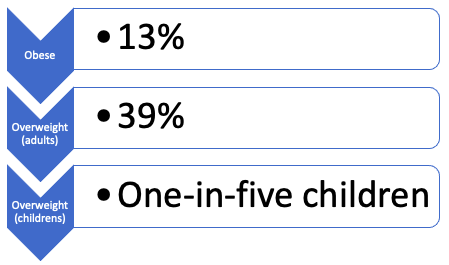Executive Summary
Obesity is a global epidemic affecting millions of people worldwide. Statistics on how many people in the world are obese and overweight are presented in Appendix A. Diabetes, coronary heart disease, arterial hypertension, cancers, reproductive issues, gastrointestinal ailments, and musculoskeletal disorders are all common complications. Access to medical care is necessary to treat various conditions and prevent long-term effects, but there are differences in access due to obesity.
Insurance coverage, practitioner bias and prejudice, and access to healthcare services can contribute to obesity-related health disparities. Eliminating disparities in access to obesity-related health care involves removing barriers and eliminating prejudice and discrimination based on weight. Healthcare providers must be trained on weight bias and discrimination and treat all patients respectfully and fairly. Inclusive health is a core life value and should be made mandatory in large cities, while physicians in smaller communities should be aware of it.
Introduction
Health disparities are often defined as gaps in health status between groups of persons with better or poorer socioeconomic circumstances. These assumptions reinforce racial stereotypes even though racial and ethnic discrimination is illegal and diverts attention from persistent structural barriers to socioeconomic opportunity. Health disparities are a particular type of health disparity, or the most important factors affecting health, that could be determined by public policy.
It is a systematic difference in health based on social advantage, characterized by wealth, power, and reputation in the social hierarchy. The distinction is that disadvantaged social groups, such as obese individuals, consistently have poorer health outcomes or face more health risks than less vulnerable social groups (Eng et al., 2022). Health disparities include comparisons between the top and lowest performing groups in a specific category, as well as comparisons between the most socially advantaged group and the rest of the population.
Main Text
Obesity is a major public health issue that affects millions of people globally. However, many obese persons have inadequate access to health care, which can worsen their health issues and make weight control harder. Obesity persons are frequently stigmatized and discriminated against, which might influence medical professionals’ attitudes (Eng et al., 2022). Stigmatization can result in worse care, less attention to their health issues, and limited access to health services. Obese persons may be unable to access certain medical procedures and equipment, restricting the medical treatment they can obtain.
Furthermore, certain medical institutions may lack the physical capacity or resources to treat many patients, further restricting access to care. Obese people may experience greater healthcare expenses due to an increased risk of obesity-related health disorders. Due to these prices, some people may find obtaining the necessary medical treatment difficult. Some healthcare providers may not have the necessary experience or knowledge to effectively care for obese patients, resulting in suboptimal treatment or limited access to care. In some places, healthcare facilities may be limited or difficult to access, making it difficult for people with obesity to receive care.
It is important to raise awareness of the difficulties obese people face in obtaining health care and to strive to minimize stigma and discrimination to address these problems (Eng et al., 2022). Additional training for healthcare providers to better care for obese patients may also be helpful. Policymakers can take steps to improve access to care, such as increasing funding for obesity-related research and improving the availability of resources and equipment for obese patients. The policy implications would be a reduction in obesity-related deaths and morbidity.
However, the main policy that needs to be introduced is to teach healthcare workers about inclusion and equal treatment of all patients. This will help to reduce the development of obesity-related diseases as well as reduce inequalities. The consequence of this policy would be that obese people would no longer be afraid to go to medical institutions and undergo various screenings and preventive procedures. This will help to reduce mortality and morbidity in this population.
Table 1 – Rating of Countries by the Number of Obese People (%).
(Templin et al., 2019)
References
Eng, C. W., Lim, S. C., Ngongo, C., Sham, Z. H., Kataria, I., Chandran, A., & Mustapha, F. I. (2022). Dietary practices, food purchasing, and perceptions about healthy food availability and affordability: a cross-sectional study of low-income Malaysian adults. BMC Public Health, 22(1), 192. Web.
Templin, T., Cravo Oliveira Hashiguchi, T., Thomson, B., Dieleman, J., & Bendavid, E. (2019). The overweight and obesity transition from the wealthy to the poor in low-and middle-income countries: A survey of household data from 103 countries. PLoS medicine, 16(11), e1002968. Web.
Appendix A
